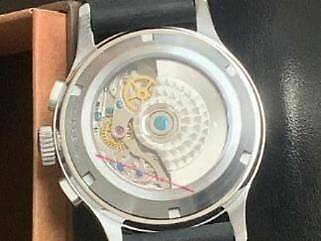Strela watches
If you have checked previous subsections you might wonder yoursef how come that first soviet cosmonauts havent't used chronograph watch but a simple watch with stop second complication, even though a lot of chronograps already existed at that time. The reason for this might be that the soviet watch industry was at that time one or two steps behind in the development of chronograph watches. 1MČZ developed first chronograph based on Type 1 movement just before the second world war, but war stopped final production. For the special pilot needs they also copied Valjux 61 but again just in minor numbers.
After the second world war Soviet union confiscated entire German watch company's stocks and watches Urofa. They assembled Urofa chronographs, even made some parts for that movement. But again this was very limited.
2MČZ developed at the early fifties it's own one pusher pocket watch chronograph. But it's movement was to big to be used in wrist watches.
At the late fifties finally first serious development of chronograph wrist watch began. 1MČZ used Venus 150 movement with the column wheel as the template. Legend was born! The result was movement 3017, watches with this movement are now known world wide as "Strela", which was the name of the first watch with this movement. Even though just few versions of the watches really had Strela description on the watch dial all watches with this movement are in general called Strela.
Soon after release of the watch Soviet space program of course took new chronograph as their official watch. They were too late to own the title "First chronograph in space", but Strela got another important title. It was the first watch by which EVA - extravehicular activity or space walk was done. That was done on 18.3. 1965 by Aleksej Leonov.
Almost all Strela production was used for military purposes, civil versions were available much latter, more than 10 years later. Strela watches were produced somewhere to 1974 when movement 3133 replaced 3017.
In the total production time arround 30 different versions were produced. They have different inscriptions on the dial such as Strela, Strela kl.1, Poljot (all three in latin and cyrillic), Sekonda, Exacta, different types of dials ("clean", tahymetric scale), different hands (straight and paddle ones), different backplates, etc.
I used to have 10 different versions, now I still have 5. For the collectors the most wanted are cyrillic models, which have cyrillic Strela inscription on the dial and movement is also stapmed in cyrillic.




The rest of the watches have the same movement as upper one, so I do not show them.



Molnija issued also pocket watch edition. Even though name is on the dial written in cyrillyc, movement it latin. I don't know if this is standard but my guess is that Molnija produced Strela's when comercial version of the movement with latin stamps was produced.


Due to huge popularity it is quite normal, that Strela watches were and are reiisued from different companies and on different ways. Most of them used newer Poljot 3133 movement, which has also date. I had some models but I got rid of almost all of them, I still have just the Poljot International one which was of the best quality among all that I had. Again I have to point out the better assembly of 3133 movement in Poljot International watch.


I have also found one Strela with quartz Seiko VK64A movement, made by company Univaque:


The special story is the company Strela Watches from Germany. That company obviously is specialized in making Strela heritage watches. One of them was already presented in the alarm collection:

For me the most interesting are the chronograph watches where Seagull ST19 movements were used. Seagull ST19 is at the moment the closest movement to original Poljot 3017 movement, the only difference is that Seagull also have shock resistance, which 3017 didn't have. And it has 2 jewels more. I have one reissue with Seagull St19 movement.
Seagull developed also automatic version of Seagul ST19 movement, it's named Seagul 1940. Strela watches also made series of watches with this movement so this give us an impression how would Strela work if soviets would upgrade 3017 to automatic version...


